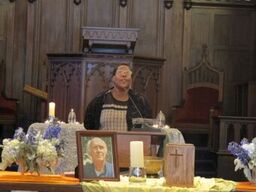By Chuck Currie
It is with grand sadness that I am unable to join in the celebration of the life of Michael Stoops. I was honored to have been invited to officiate at the service, lifting up the gifts Michael brought to our nation in the long and on-going struggle to end homelessness.
The story of our first meeting has often been retold in speeches and by the media. Michael came to my high school when I was a junior in 1986 to give a presentation on homelessness in Portland. At the conclusion, he asked for students to volunteer at Baloney Joe’s. I raised my hand and offered to help, but a busy high school life got in the way.
Michael returned to my high school the following year and noted that homelessness had increased since his last visit. There was a reason, he said. Pointing at me, Michael said it was because people like me don’t keep their commitments to help. He had somehow remembered me from the year before and my unfulfilled promise to volunteer.
I went to volunteer at Baloney Joe’s the next weekend.
Our lives would be professionally and personally connected for the next thirty years. I knew him in my role as a board member with Burnside Community Council and later as a board member with the National Coalition for the Homeless. We would join forces at protests across the country. We’d speak wherever asked.
When he discovered that I had never seen the Grand Canyon, Michael insisted we drive the six hours there overnight and six hours back in time for our presentation because we were “so close” when we were in Arizona for a speaking gig.

Knowing Michael was never easy. He built up thick layers to keep himself safely distanced from others so that he would not be hurt as he had been before. Long after I married and had children, Michael still sent me a birthday card each year with a check inside. He didn’t like to acknowledge his birthday, but I would call him every year on that day with some made-up excuse to talk about one policy issue or another.
Beverly “Ma” Curtis, Rev. Spencer Marsh, Gene Ediger, Sister Mary Kay Lampert. These are just a few of the heroes of Baloney Joe’s and Burnside Community Council that we have lost over the last thirty years. Now we add the name of Michael Stoops to this Great Cloud of Witnesses whose spirits continue to surround us with love.
Michael, my friend, I will miss you. To those who read this, please write a postcard or send an email to your member of Congress urging that the Trump policies proposed in the president’s budget be rejected and that a moral budget be adopted that works to end homelessness and poverty.
Something to Live By
When I first met Michael Stoops in December 2015, the entrance to the Wilson Building was crowded, full of advocates and reporters making their way through the metal detectors. Julie Turner, Street Sense’s social worker, wheeled him up to us.
“Here’s Michael!” she said.
“Michael Stoops!” someone else shouted in excitement.
I knew of Michael through news articles and word of mouth stories. I knew he was one of the most influential advocates for people experiencing homelessness, unyielding since the days of the Reagan Administration who never stopped fighting. I heard he had had a stroke, but didn’t know what that entailed. I would learn that day that Michael couldn’t speak or walk. But I would learn that day and in the months that followed that his mind was still present, along with his tireless work ethic.
When I returned home from college for the summer, I shifted gears from journalism to social work and started my internship with Julie. After work, we would often drive to Maryland to visit Michael. Rarely didy a week go by without a visit to him. Julie’s primary goal was to keep Michael engaged, so we read him his mail and we read him issues of Street Sense. In this vein, Julie asked me to interview Michael for Street Sense. I wasn’t sure how that would work. He had a lifetime of stories and knowledge to give, but no way to verbally express himself. After some brainstorming, we devised a system: a list of questions, each one capable of being answered with a nod or shake of the head. For more complicated questions, I listed all the possible answers we thought he may have, based on past interviews.
During our interview, I truly got to see the side of Michael everyone had told me about. I saw the man who never stopped working, who was the last to leave the office, and who refused to give up. When he had difficulty communicating the answer to one question, he gestured for me to come closer. He was determined to write “no” next to one of the questions on the sheet, to make sure I understood what he meant, even if writing the word meant using all the energy he had. Despite his physical limitations, Michael never stopped trying to advocate for people experiencing homeless.
At Michael’s service, Julie said something that I had not been able to articulate until then: “Michael is you and you are Michael,” she told the crowd. And it is true. Michael’s impact on the D.C. community and nationally made knowing him, without ever having a verbal conversation with him, possible.
In many ways, his work spoke for itself.
I believe Michael will live on through the people whose lives he changed, which makes his memory more than just a memory: it makes Michael’s life an example of how to live ours.




